Bride of the Monster
4.2 /10 1 Votes4.2
45% Rotten Tomatoes Genre Horror, Sci-Fi Country United States | 4.1/10 IMDb Film series Bride of the Monster Duration Language English | |||||||||||||||||||||||||||||||||
 | ||||||||||||||||||||||||||||||||||
Release date May 11, 1955 (1955-05-11) Writer Edward D. Wood Jr. (original story and screenplay), Alex Gordon (original story and screenplay) Cast (Dr. Eric Vornoff), Tony McCoy (Lt. Dick Craig), (Lobo), (Janet Lawton), (Capt. Robbins), George Becwar (Prof. Strowski)Similar movies The Lazarus Effect , Surviving Evil , Alien from L.A. , Tokolosh , Project Shadowchaser II , Snake Island | ||||||||||||||||||||||||||||||||||
Bride of the Monster is a 1955 American science fiction horror film directed, written, and produced by Edward D. Wood, Jr., and starring Bela Lugosi, along with Tor Johnson, Tony McCoy, and Loretta King.
Contents
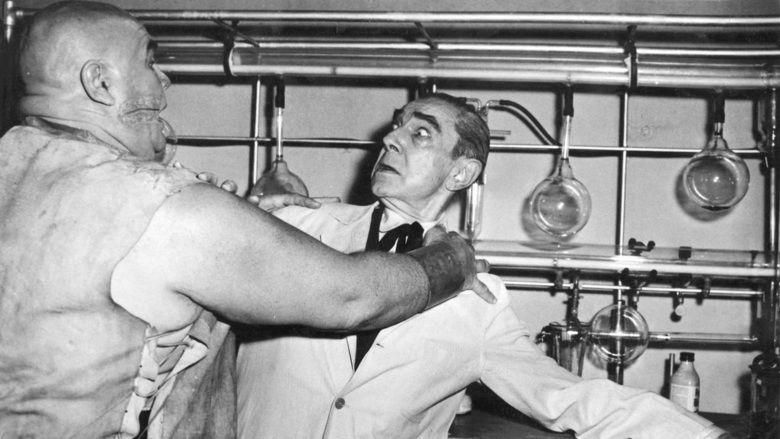
The film is considered to have Wood's biggest budget ($70,000). Production commenced in 1953 but, due to further financial problems, wasn't completed until 1955.
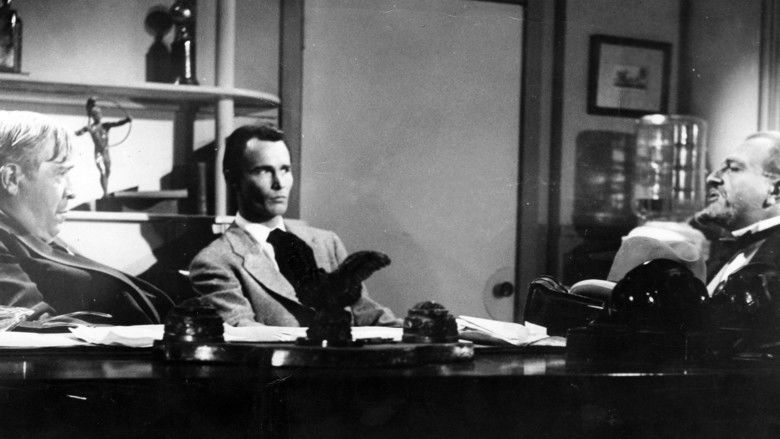
A sequel, entitled Night of the Ghouls, was finished in 1959, but due to last-minute financial problems, was not released until 1987.

Plot
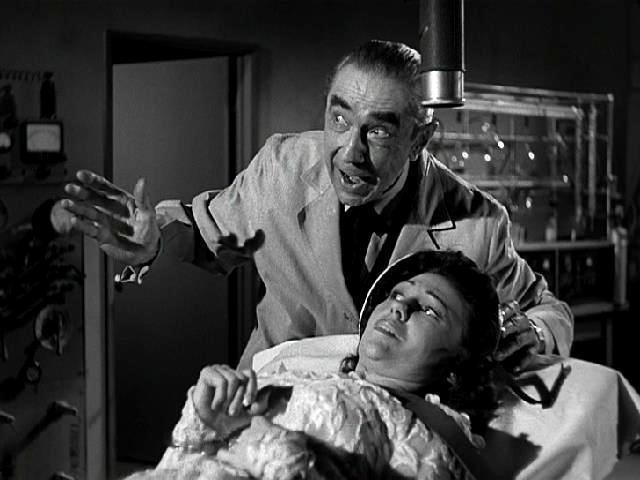
In a stretch of woods, two hunters are caught in a "raging thunderstorm". They decide to seek refuge in Willows House, which is supposedly abandoned and haunted. When they reach Willows House, they find it to be occupied and the current owner repeatedly denies them hospitality. One of the hunters attempts to force his entry into the house, but a giant octopus is released from its tank and sent after the intruders. One of the fleeing hunters is killed by the octopus, while the other is captured by the giant. The owner is a scientist, Dr. Eric Vornoff, and the giant is his mute assistant, Lobo. Vornoff explains that he will perform an experiment on the unwilling hunter, who dies on the operating table.

In a police station, Officer Tom Robbins sees Lieutenant Dick Craig. There are now 12 missing victims, and the police still do not know what happened to them. The reporter behind the newspaper reports is Janet Lawton, Craig's fiancée. Janet forces her way into the office and argues with Robbins, and vows to go to Lake Marsh to investigate. At the police station, Robbins and Craig have a meeting with an intellectual from Europe, Professor Vladimir Strowski, who agrees to assist the police in investigating the Marsh, but not at night. As night falls and another storm begins, Janet drives alone to Lake Marsh, but visibility is poor and she drives off the road and into a ravine. Lobo rescues her.

Janet awakens to find herself a prisoner of Vornoff, who uses hypnosis to put her back to sleep. The following day, Craig and his partner drive to the area around Lake Marsh, a swamp. The partners also discuss the strange weather and mention that the newspapers could be right about "the atom bomb explosions distorting the atmosphere". The duo eventually discover Janet's abandoned car and realize she is the 13th missing victim. They leave the swamp while, Strowski drives a rented car to the swamp.
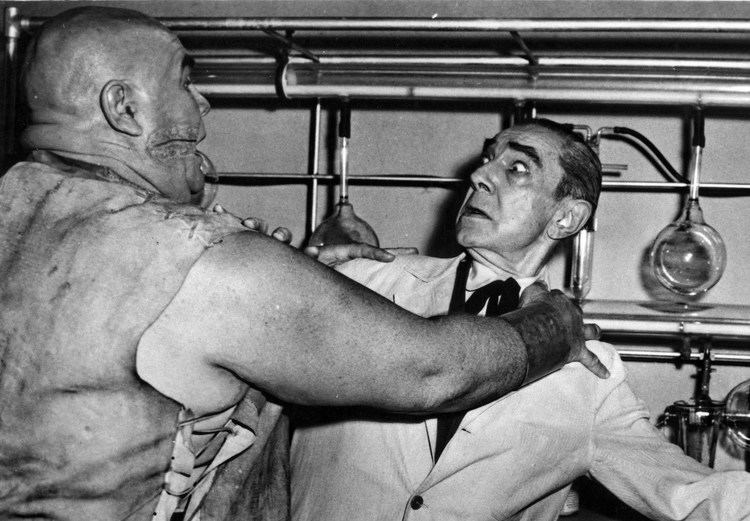
Janet awakens at Willows House. Vornoff assures her that Lobo is harmless, but the giant seems fascinated with the female captive and approaches her with questionable intent. Vornoff explains the giant is human and that Vornoff found him in the "wilderness of Tibet". Vornoff then hypnotically places Janet back to sleep. He orders Lobo to transport the captive to Vornoff's private quarters. Meanwhile, Strowski silently approaches Willows House and enters through the unlocked front door. While Strowski searches the house, Vornoff arrives to greet him. Their country of origin is interested in Vornoff's groundbreaking experiments with atomic energy and wants to recruit him. Vornoff narrates that two decades prior, Vornoff had suggested using experiments with nuclear power which could create superhumans of great strength and size. In response, he was branded a madman and exiled by his country. Strowski reveals that he has dreams of conquest in the name of their country, while Vornoff dreams of his creations conquering in his own name. By late evening, Craig and his partner return to the swamp and discover Strowski's abandoned car. The partners split up to search the area, Craig heading towards Willows House. Back in the secret laboratory, Vornoff uses a wave of his hand to summon Janet to his current location. She arrives dressed as a bride, summoned through telepathy. He has decided to use her as the next subject of his experiments. Lobo is reluctant to take part in this experiment, and Vornoff uses a whip to re-assert his control over his slave and assistant. Meanwhile, Craig has entered the house and accidentally discovers the secret passage. He is himself captured by Vornoff and Lobo.
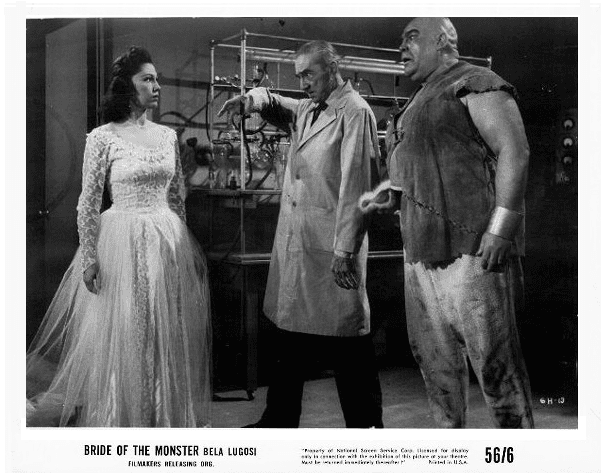
As the experiment is about to begin, Lobo, is visibly distressed. Taking his decision, Lobo rebels and attacks Vornoff. After a fight, Lobo knocks Vornoff out, releases Janet, and transports the unconscious Vornoff to the operating table. The scientist becomes the subject of his own human experiment. This time the experiment works and Vornoff is transformed to an atomic-powered superhuman being. He and Lobo physically struggle with each other, and their fight destroys the laboratory and starts a fire. Vornoff grabs Janet and escapes from the flames. Robbins and other officers arrive to help Craig. The police pursue Vornoff through the woods. There is another thunderstorm, and a lightning strike further destroys Willows House. With his home and equipment destroyed, a distressed Vornoff abandons Janet and merely attempts to escape. Craig rolls a rock at him and lands him in the water with the octopus. They struggle until a nuclear explosion obliterate both combatants, apparently the end result of the chain reaction started at the destroyed laboratory. Robbins comments that Vornoff "tampered in God's domain".
Production and release
The first incarnation of the film was a 1953 script by Alex Gordon titled The Atomic Monster, but a lack of financing prevented any production. Later Ed Wood revived the project as The Monster of the Marshes. Actual shooting began in October 1954 at the Ted Allan Studios, but further money problems quickly halted the production. The required funds were supplied by a rancher named Donald McCoy, who became the film's producer. He also provided his son to star as the film's hero. According to screenwriter Dennis Rodriguez, casting the younger McCoy as a protagonist was one of two terms Donald imposed on Wood. The other term was to include an atomic explosion in the finale. Production resumed in 1955 at Centaur Studios.
The film premiered at Hollywood's Paramount theater in May 1955, under the title Bride of the Atom. The film was reportedly completed and released through a deal with Samuel Z. Arkoff. Arkoff profited from the film more than Wood, and his earnings contributed to the funding of American International Pictures. The end credits identify the copyright holder of the film as "Filmakers Releasing Organization". Distribution rights were held by Banner Films in the United States, and by Exclusive in the United Kingdom.
Genre and background
The film combines elements of science fiction and horror fiction, genres which were frequently combined in films of the 1950s. Like many of these contemporaries, Bride serves in part as a Cold War propaganda film. Once again, an external threat from "Old Europe" serves as the enemy of the righteous United States. In Cold War thrillers, foreign nations served as a vilified and demonized Other for American audiences. The country of origin for Vornoff and Strowski is left unnamed. The only clues is that it is European and has its own dreams of conquest. By implication, the country which exiled Vornoff in the 1930s could be Nazi Germany or the Soviet Union. Their role as villains for the American cinema had already been solidified by the 1950s, and Wood could be alluding to both of them. Strowski uses the term master race, which is a key concept in Nazism.
Both the working title Bride of the Atom and the final title Bride of the Monster allude to the earlier film Bride of Frankenstein (1935). The film otherwise follows the template of the Poverty Row horror films of the 1940s. The Atomic Age influences the film in its ominous implications concerning nuclear weapons and the threat they posed towards human civilization. Rob Craig makes an argument for including the film in a subgenre of Cold War-themed thrillers along with Kiss Me Deadly (1955), The World, the Flesh and the Devil (1959), On the Beach (1959), The Manchurian Candidate (1962), Dr. Strangelove (1964), Seven Days in May (1964), and Fail-Safe (1964).
Content
This was Bela Lugosi's last speaking role in a feature film. Lugosi subsequently played a silent part in The Black Sleep (1956). Plan 9 from Outer Space (1959) uses silent archive footage of Lugosi, but he died prior to the creation of its script. The footage was from an unfinished film called The Vampire's Tomb. Lock Up Your Daughters (1959) recycled footage from Lugosi's earlier films, possibly mixed with some new material. According to Rob Craig, in Bride Lugosi for the last time plays "a charismatic villain whose megalomania leads to downfall and destruction". Craig considers this to be one of Lugosi's finest roles, citing the surprisingly energetic performance of the aging actor. The scenes involving hypnosis contain close-ups of Lugosi's eyes. Wood was probably trying to re-create similar scenes from an older film of Lugosi, White Zombie (1932). Lugosi did not actually play Vornoff in the scenes demanding physical combat. The film made use of body doubles for Lugosi: Eddie Parker and Red Reagan. Parker was also the body-double of Lugosi in Frankenstein Meets the Wolf Man (1943). Lugosi's fee for the film is estimated at 1000 dollars.
The story could almost be a sequel to an earlier Bela Lugosi movie, "The Corpse Vanishes". (Each bride at her wedding was given an orchid, which she sniffed before passing out. In "The Corpse Vanishes" Bela played a doctor who captured the brides and took some kind of liquid from each bride's body and injected it into his wife to make her temporarily young again. Characters included his wife, an old woman, the old woman's grown son, and a dwarf.) In "Bride of the Monster" Bela again plays a doctor doing experiments, but his only housemate/assistant is Lobo, and when his experiment fails to turn someone into an "atomic-powered superman", he throws the dead body to an octopus or an alligator, similar to what Bela did in "Murders in the Rue Morgue".
The hunters of the opening scenes are unnamed in the actual scenes, but identified later in the film as Jake Long and Blake "Mac" McCreigh. According to the credits, Jake was played by John Warren and Mac by Bud Osborne. The police office scenes feature cameos by a drunk and a newspaper seller. The former is played by Ben Frommer (known for playing Count Bloodcount in Transylvania 6-5000), the latter is played by William Benedict (known as one of The Bowery Boys). Janet Lawton briefly speaks with a co-worker called Margie. Margie is played by Dolores Fuller. Dick Craig's partner, Martin, is played by Don Nagel. Both Fuller and Nagel had worked with Wood in Jail Bait (1954).
The film uses both stock footage of a real octopus and a fake, rubber octopus in scenes where "the monster" interacts with actors. It is widely believed this is a prop from the film Wake of the Red Witch (1948). Contradictory accounts claim that Wood either stole or rented the prop from Republic Pictures, which produced the earlier film. The struggle between Vornoff and the octopus was filmed at Griffith Park.
Craig comments that there is a stark contrast between the characters of Dick Craig and Janet Lawton. Dick speaks in a deadpan unemotional way and seems to be a rather lethargic character. Janet is a "brassy girl reporter", a dynamic character with a sense of autonomy. The role was reportedly intended for Dolores Fuller. According to Fuller's recollections, Loretta King bribed Wood into casting her as Janet, with promises of securing further funding for the film. Fuller was so reduced to a cameo role. King vehemently denies bribing Wood, so the story lacks confirmation.
In a subplot of the film, there are storms every night for three months and strange weather patterns. The characters attribute the phenomenon to the effects the nuclear explosions have on the atmosphere. This probably reflects actual anxiety of the 1950s about potential climate change. Until the Partial Nuclear Test Ban Treaty (1963), atmospheric nuclear weapons testing was used widely and recklessly. Rob Craig suggests that the months of constant storms could be inspired by the Genesis flood narrative. In the context of the film, the strange weather is implied to be a side-effect of the experiments of Vornoff which apparently release radioactivity to the atmosphere.
The dialogue of the film includes memorable lines such as "Home? I have no home!" and "One is always considered mad, when one discovers something which others cannot grasp". The phrases could well apply to the fates of avant-garde artists and thinkers. The title "Bride of the Atom", which Vornoff uses for Janet in the bridal dress, is inexplicable unless the scientist is actually attempting to use Janet to replace his long-lost wife. One of his re-assuring lines to Janet concerning the experiment, "It hurts, just for a moment, but then you will emerge a woman...", sounds as if preparing her for the loss of her virginity. The scene of a young woman, in a bridal gown, restrained by leather shackles seems to be sadomasochistic in nature.
Throughout the film, the mute Lobo is implied to have an unspecified intellectual disability and to be of sub-human intelligence. Yet he successfully operates complex machinery as if trained to do so. Craig views this scene as implying that supposedly "dumb" servants, can have a capacity of learning the secrets of their masters .
The final scenes, with the mushroom cloud of the nuclear explosion, use stock footage from the blast of a thermonuclear weapon ("hydrogen bomb").
Film series
The apparent fetish of Lobo with angora wool is a reflection of Wood's own fetish for the material. This also serves as the film's connection to Glen or Glenda (1953), where the fetish plays a more prominent role.
The character of Lobo also appeared again in Wood's Night of the Ghouls. This film served as a sequel of sorts to Bride. Vornoff is absent from the later film, but there are references to the activities of "the mad doctor". Tor Johnson also plays a character called Lobo in The Unearthly (1957) by Boris Petroff. This character also serves the main villain.
This film is part of what Wood aficionados refer to as "The Kelton Trilogy", a trio of films featuring Paul Marco as "Officer Kelton", a whining, reluctant policeman. The other two films are Plan 9 from Outer Space and Night of the Ghouls. Kelton is the only character to appear in all three films.
Legacy
In 1986, the film was featured in the syndicated series, the Canned Film Festival and was later featured on the comedy series, Mystery Science Theater 3000.
The late '90s dream trance track "Alright", by DJ Taucher, sampled a monologue from Bela Lugosi during the interlude of the song.
In 2008, a colorized version was released by Legend Films. This version is also available from Amazon Video on Demand.
In 2010, a retrospective on the movie entitled Citizen Wood: Making ‘The Bride,’ Unmaking the Legend was included in the Mystery Science Theater 3000 Volume 19 DVD set as a bonus feature for said episode featuring the movie. Horror host Mr. Lobo is among the interviewees of the 27 minute documentary.
Controversies
In 1980, the book The Golden Turkey Awards claims that Lugosi's character declares his manservant Lobo (Tor Johnson) "as harmless as kitchen" [sic]. This allegedly misspoken line is cited as evidence of either Lugosi's failing health/mental faculties, or as further evidence of Wood's incompetence as a director. However, a viewing of the film itself reveals that Lugosi said this line correctly, the exact words being, "Don't be afraid of Lobo; he's as gentle as a kitten." The easier explanation would be that authors Michael Medved and Harry Medved saw the film in a theater setting with inferior sound quality. A single viewing in such conditions could result in mishearing some lines of dialogue. Unfortunately the inaccurate claim managed to achieve urban legend status, and it keeps circulating.
In 1994, the biopic Ed Wood, directed by Tim Burton, alleged that Wood and the filmmakers stole the mechanical octopus (previously used in the film Wake of the Red Witch) from the Republic Studios backlot, while failing to steal the motor which enabled the prop to move realistically, although, by the director's admission, the film preferred narrative interest over historical accuracy. These events are also alleged in the 2004 documentary, The 50 Worst Movies Ever Made. However, other stories circulated insist Wood legitimately rented the octopus, along with some cars. To remedy the lack of movement from the octopus prop, whenever someone was killed by the monster in the film, they simply flailed around in the shallow water while holding the tentacles to imitate movement. The filming of these scenes, as well as the production of the film in general, were played to comic effect in Ed Wood.
Rudolph Grey's book Nightmare of Ecstasy: The Life and Art of Edward D. Wood Jr. contains anecdotes regarding the making of this film. Grey notes that participants in the original events sometimes contradict one another, but he relates each person's information for posterity. He also includes Ed Wood's claim that one of his films made a profit and surmises that it was most likely Bride of the Monster, but that Wood had oversold the film and could not reimburse the backers.
References
Bride of the Monster WikipediaBride of the Monster IMDbBride of the Monster Rotten TomatoesBride of the Monster themoviedb.org
